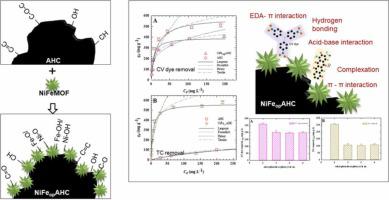Journal of Environmental Chemical Engineering ( IF 7.7 ) Pub Date : 2021-09-15 , DOI: 10.1016/j.jece.2021.106367 Farahin Mohd Jais 1 , Shaliza Ibrahim 2 , Ching Yern Chee 3 , Zubaidah Ismail 1

|
In this study, the bimetal organic framework incorporated on the sugarcane bagasse hydrochar (AHC) surface (NiFe-MOF@AHC) composite was prepared using a solvothermal method. The preparation parameters (concentrations of Ni(NO3)2, FeCl3, H4BTeC, and reaction time) were optimized via the response surface methodology-central composite design (RSM-CCD) for the high adsorption removals of the large-sized pollutants (crystal violet (CV) dye and tetracycline (TC)). The optimized NiFe-MOF@AHC (NiFeopAHC) was characterized with dual three-dimensional (3-D) structures of intertwined nanosheets porous networks and hexagonal spindle-shaped crystals with mesopore structures 2.3 times higher than the surface area of AHC, ample carboxylic and metal-carboxylate groups, and high thermal stability at a wide temperature range (0–800 °C). The NiFeopAHC composite adsorption removal of both CV dye and TC demonstrated a fast removal rate, primarily by chemisorption. The maximum adsorption removal (Qmax) of NiFeopAHC for CV dye (395.9 mg g−1) was 1.5 times lower than that of AHC, but the removal of TC (568.1 mg g−1) was 2.7 times higher than that of AHC. The hydrogen bonding, π-π or π-EDA interactions, surface complexation, and acid-base interactions might play roles as the dominant mechanism for the removal of the CV dye/ TC. The regeneration studies showed that the removal of both CV dye and TC was reduced after the 1st cycle and maintained until the 4th cycle, demonstrating that the solvothermal growth of NiFe-MOF on AHC succeeded in producing a stable and recyclable adsorbent.
中文翻译:

双金属有机骨架(NiFe-MOF)在甘蔗渣水炭上的溶剂热生长去除染料和抗生素
在这项研究中,使用溶剂热法制备了掺入甘蔗渣水焦 (AHC) 表面 (NiFe-MOF@AHC) 复合材料的双金属有机骨架。通过响应面法-中心复合设计(RSM-CCD)优化了制备参数(Ni(NO 3 ) 2、FeCl 3、H 4 BTeC 的浓度和反应时间),以实现大尺寸的高吸附去除。污染物(结晶紫(CV)染料和四环素(TC))。优化的 NiFe-MOF@AHC (NiFe opAHC) 的特征在于交织纳米片多孔网络的双重三维 (3-D) 结构和六角纺锤形晶体,其介孔结构比 AHC 的表面积高 2.3 倍,具有充足的羧基和金属羧酸盐基团,以及高热在较宽的温度范围内(0–800 °C)稳定。NiFe op AHC 复合吸附去除 CV 染料和 TC 显示出快速去除率,主要是通过化学吸附。NiFe op AHC 对 CV 染料 (395.9 mg g -1 )的最大吸附去除率 ( Q max )比 AHC 低 1.5 倍,但对 TC 的去除率 (568.1 mg g -1) 是 AHC 的 2.7 倍。氢键、π-π 或 π-EDA 相互作用、表面络合和酸碱相互作用可能是去除 CV 染料/TC 的主要机制。再生研究表明,CV 染料和 TC 的去除在第 1 次循环后减少并保持到第 4 次循环,表明 NiFe-MOF 在 AHC 上的溶剂热生长成功地产生了稳定且可回收的吸附剂。



























 京公网安备 11010802027423号
京公网安备 11010802027423号